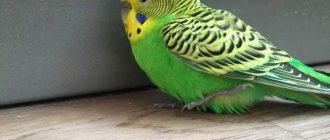Hamsters are small creatures that should bring a smile to both children and adults. People are used to associating hamsters with childhood, with sudden joy. But things don’t always go smoothly; sometimes problems arise. If you combine two rodents, a conflict often breaks out between them, as a result of which the animals begin to fight. Owners must understand why hamsters fight with each other.
Causes of fights between hamsters
Keeping hamsters at home is painstaking work.
Despite its dwarf size, this animal, like other pets, needs to be provided with proper living conditions - a balanced diet, an active lifestyle, comfortable and spacious housing. The last point is one of the most important. After all, living together of rodents can lead to a fight or their death. In this article we will tell you why hamsters fight and what to do in such a situation. Fights between hamsters
What types of hamsters can be given cabbage?
Hamsters mainly eat plant foods: grains, seeds, herbs and vegetables. The food should be fresh and varied. Many owners wonder if their hamster can eat this vegetable?
Let's look at the example of three breeds of hamsters:
- Syrian. A small rodent, the size of an adult's palm. Known as the “golden hamster” due to its sandy-reddish coloration. Rodents of this breed should not be given cabbage, the reason is due to the structural features of the gastrointestinal tract. The esophagus passes into the proventriculus and lacks any glands. Cabbage is too heavy a food, causes intestinal colic, gas formation, and can also lead to the death of the animal.
- Dzungarian. A pet is not fussy about food, and problems with nutrition usually do not arise. It is allowed to give cabbage to the Djungarian hamster, no more than 25 grams of product per day. Offer periodically, do not include it in the daily menu.
- Robokovsky's hamster. The hamster is small in size, commonly known as a dwarf. Rodents of this breed feed mainly on seeds, beets, plant leaves, and sedge. Cabbage is allowed to be included in the diet, the maximum serving size is 25 grams.
Fight for territory
It is the defense of their own territory that is the main reason why hamsters fight with each other. Many believe that such pets, just like humans, certainly need communication, and buy their rodent a partner. They are placed in the same cage and enjoy their games and living together. True, such an idyll does not last long.
Do not forget that such a pet prefers a lonely life and worries only about itself. In the natural environment, each such rodent of the Hamyakov family has its own territory. Moreover, the hamster does not intend to allow strangers into this territory. Well, if one of the relatives covets it, the owner of his plot begins to win it back. As a result of the bloody fight, one of the rodents dies or receives deep wounds. He becomes weak and dies after a while.
Article on the topic: Why does a hamster bite, how to stop a hamster from biting
In the same way, at home, if the hamsters living in the same cage are not housed, disastrous consequences cannot be avoided. They can simply bite each other to death.
The exception is the dwarf species. Miniature rodents can live in groups.
Alternative to a running wheel
If the measures taken have not awakened the pet’s desire to spin the wheel, then it is better to provide him with a full-fledged replacement. Despite the natural needs for active movement, there are bright individuals among hamsters who completely ignore the simulator. Such hamsters do not like running in a wheel, regardless of its material or convenient location.
Alternatively, give it to your pet for moving around inside the apartment. Hamsters willingly use this item, which provides them with an active lifestyle and freedom of movement with protection from external danger.
Walking in the ball, the hamster has a large area to run around and explore, which is attractive to rodents. By the way, sometimes it helps to teach a hamster to run in a wheel if other methods have failed. For an unknown reason, the rodent’s opinion about the drum changes, leading to active use of the “toy”.
Getting your hamster used to the wheel
Names for hamsters boys and girls: choosing a nickname for your pet
Can hamsters swim?
How to tame a hamster
Wheels: its diameter must be at least 18 cm. If the hamster is in a wheel
it’s tight - he may refuse to run in it, or he will develop problems with the spine, because he will have to arch his back strongly when running.
Check whether the wheel spins easily and whether the animal will have to make too much effort to move it. Turn the wheel yourself by hand: if it turns hard, lubricate the axle with oil.
For the safety of the hamster, it is important that there are no cross wires in its path. Otherwise, there is a risk that the baby will hurt himself
Therefore, purchase wheels with a continuous working surface. A good option would be a wheel that is completely closed on one side and open on the other so that the hamster can easily climb in and out of it.
After making sure that the wheel meets all the necessary requirements for the safety and comfort of the animal, you can introduce the hamster to its treadmill. Carefully place your pet in the wheel and cover the exit with your palm or leaf. The animal must instinctively move forward for the wheel to start spinning. If he doesn't know how to do this, try helping him with a treat.
Don't be upset if your pet doesn't immediately start running enthusiastically in the wheel - he needs to get used to the new object. Give your baby a treat every time he shows interest in the wheel. Don't forget that he is most active in the evening and so you need to make sure that the wheel is as silent as possible.
note
Even if your hamster is still small, this is not a reason to buy him a small wheel: hamsters grow very quickly. Small wheels are only suitable for dwarf hamsters.
If you have multiple hamsters, do not force them to share one wheel. Let there be several wheels too, otherwise fights may break out between the animals.
In order for your animal to be vigorous and healthy, do not limit its “gym” to just one wheel. A hamster needs a variety of exercise. Walking balls, ladders, houses and nests will not let the animal get bored.
hamster wheel
Not all hamsters need the company of their own kind. In nature, their natural habitat is the desert, in which a single individual has a much higher chance of survival. But in captivity they are quite capable of creating hamster communities or even families
At the same time, it is very important to properly introduce animals to each other so that possible friendship does not develop into ongoing enmity.
Fight between female and male
Why do hamsters of different sexes fight? This question is especially interesting for novice livestock breeders. It is necessary to bring a female and a male together in the same cage only during the breeding season, when love hormones prevail over the instinct of self-preservation and defense of one’s own territory. Immediately after mating, the couple must be separated. Otherwise, the male and female get into a fight. Regardless of whether they are Djungarians or Syrians, the outcome is the same - one of the rodents dies.
Some breeders place the male's cage next to the female's cage. The male smells when the female is ready to mate and enters her cell through a special passage. After mating has taken place, the female begins to show aggression towards the male, thus driving him out of her cage. The male catches this and immediately returns to his home.
Females show particular hatred towards each other. Each female, living in the same cage with a hamster, perceives her as a rival, and is ready to bite her to death at any moment. Therefore, try not to confuse the gender when you are going to match a male with a female.
Hamsters can't live together peacefully
Relationships with the opposite sex
The exception is the mating period. At this time they are quite peaceful, the call of the flesh wins for some time. But then the territorial borders are restored and carefully guarded - this is what happens in nature. How do domestic hamsters resolve issues with the opposite sex?
Those who breed hamsters still keep the males separately. Their cells stand next to each other and are connected to each other. When the female is ready to mate, she calls for the male with a pungent odor emanating from her. And then he goes into his cage, into his territory. She no longer needs him, and besides, during pregnancy she becomes even more aggressive. Hamsters do not recognize any family ties. The mother perceives her children while she feeds them milk, but then they are just rivals for her, whom she needs to get rid of by clearing the territory.
Female and cubs
The same can be said about a mother with cubs. While the hamsters are defenseless and need mother's milk, the hamster treats them loyally. As soon as the cubs grow up and begin to lead an independent lifestyle, the female sees them as competitors vying for her home. Therefore, they urgently need to be isolated from their aggressive mother and housed separately in different cages. When relocating young animals, some features should be taken into account:
- rodents must eat adult food;
- Young hamsters can be separated after they reach 3 weeks of age.
Article on the topic: Is it possible to keep a dwarf and a Syrian hamster alone; will two hamsters get along together?
Considering that Djungarian and Syrian hamsters are nocturnal, you won’t be able to see them fight. If there are any battles, it will only be at night. In the morning you will see a not very pleasant picture. At best, you will see wounded animals, at worst, no longer breathing.
Even if the hamsters start a fight, after which they remain unharmed, you should not flatter yourself with the hope that this is all over. The fights will be repeated until one of the animals destroys the other.
Good day, dear subscribers.
Many owners of these small pets have two or more pets at once, without thinking about whether this is possible. It would seem that the reason is very simple - one pet will be bored and needs company. In fact, it's not like that.
School hamsters can be a very funny sight, and at first glance they can look very friendly. The animals sleep in one ball of fur, jostle funnyly, running together in a wheel, and can look after each other by licking the fur of their relatives. This whole idyll can end at any moment for one simple reason: hamsters are solitary, territorial animals. Previously friendly pets can become irreconcilable enemies and there is no way to fix this; fights will continue until one of the hamsters dies. In case of conflicts, it does not matter who the hamsters are related to each other and what gender they are. Females will fight with females in exactly the same way as males with males or hamsters of different sexes.
Territorial behavior applies to almost all types of hamsters, mainly to the most popular for home keeping - Syrian and Djungarian hamsters. In nature, these two species live alone, at a great distance from each other, meeting only to mate. Some types of hamsters can remain living in one hole in a small flock, but conflicts are not uncommon among such settlements; it is also uncommon for them to remain the same composition for a long time, new ones are born, and former members of the family leave. In a cage, even a large one, if there is a disagreement, the hamsters will not have the opportunity to independently isolate themselves from each other, and if the owner does not do this himself in time, one day he may find one of the pets dead.
Will the hamster get bored?
A hamster does not need to communicate with its relatives, so having a companion to entertain your pet is a dangerous undertaking and carries more risk than it is necessary. To prevent your pet from getting bored alone, you need to make his cage as comfortable as possible. Various pipes, ladders, branches for grinding teeth and a wheel - this way the hamster will not get bored even without human attention.
If you need to make friends with hamsters.
If for some reason two hamsters still need to get along in the same cage, you need to exclude everything that could provoke a conflict. It is advisable to have all toys in duplicate, there should be at least two houses, and hamsters should always have access to food and fresh water. This will reduce the likelihood of conflicts, but cannot eliminate it completely. It is worth remembering that even with warm communication between two hamsters who do not leave each other, they can experience stress due to this situation and would immediately separate at the first opportunity in the wild. The best way to take care of your pets here is to move them away at the first sign of conflict: squeaking at night; wounds on animals; demonstrative avoidance of each other; freezing when two hamsters approach each other.
Under what conditions can hamsters be bred?
How to fix the situation
What to do if hamsters fight? Having seen such a bloody massacre at least once, you need to urgently take action - resettle the rodents separately. Only in this way can you provide your pets with a calm, safe and comfortable life.
You should be very careful when disengaging angry rodents, as they can harm you with their bites. To do this, use gloves with thick rubber and other available means and objects.
If you have dwarf hamsters that are allowed to be kept in one cage, try to keep them occupied as much as possible. Install a wheel, ladder and other items in the cage for active pastime. This way they will be distracted, excluding the thought of attacking their relatives. Although such cases have not previously been reported in this breed.
Why do hamsters fight?
Most people associate an animal like a hamster as a small, fluffy and harmless creature. Not many people know that such animals can be very aggressive and, if they get into a fight with their relatives, most often for one individual this trouble will end in death. Often, having placed two hamsters in the same cage, the owners notice that the rodents are starting a fight with each other. So why do hamsters fight and what should the owner do if a fight is detected? Let's try to figure it out together.
Article on the topic: How many years do Djungarian hamsters live at home and what affects their life expectancy
Bloody massacre
Please don’t indulge yourself in the illusion that they live in the same cage with me and don’t fight. Everything for the time being. Let's look at the following statistics: three out of five fights between hamsters end in the death of one of them or severe injuries - at best. You won’t even have time to separate them and won’t be able to: they will sort things out at night. You will see how it all ends in the morning... It will be terrible!
It is better to prevent this and place them in separate cages. After all, the question of why hamsters fight is a very serious one, to act without permission and put your beloved animals at risk.
The first reason is territory
The first and quite common reason why hamsters start fighting with each other is territory. Since we humans are accustomed to communicating with others, this affects us when buying animals, for example, hamsters. They are often bought in pairs and placed in the same cage, as they believe that the rodents will get along together. But no one thinks about the fact that a hamster is a loner and does not need company in the same cage.
Wildlife dictates that each animal has its own territory, which no one else is allowed to enter. And if someone breaks this rule, a fight breaks out, and the end of such a showdown could be sad. A weaker animal has minimal chances of surviving such a fight.
Ignorance of hamster behavior before purchasing one often leads to injury or death of a new pet. Having placed two animals in one cage, people wonder why the hamsters fight, but no one will think that the rodents are defending the territory that belongs to one of them, and such a pair must be resettled.
If you want to keep several individuals in one cage, pay attention to the Roborovsky hamster breed. These little fluffies get along well in a group in one cage, but still each individual requires sufficient space for itself.
When to place animals
Quarrels often arise between cohabiting rodents, which are not always a signal for resettlement. Older or stronger individuals sometimes show dominance by making loud squeaks and chasing neighbors. Such outbursts of aggression do not last long and cannot be interfered with.
When cases of aggression become more frequent and methods of dominance become more severe, animals should be housed. For example, this must be done if one of the pets drives a neighbor into a corner, does not allow him to eat or sleep, or bites.
Fight between male and female
Fights happen not only between same-sex hamsters, but also between opposite-sex hamsters, and then the question arises: why do a female and a male, placed in the same cage, fight?
If hamsters cannot be in the same cage, then how do animals mate? During this period, hamsters are still housed with each other, since under the influence of hormones they are more friendly and less prone to aggression than in the normal period of life.
Article on the topic: Why does a hamster lose hair and peel off its skin: is it shedding or is it sick?
For mating, the following trick is sometimes used - the cage of the female and the male is placed close to each other so that the male can calmly come to the smell that the female gives off. After the mating process is completed, the female does not need the male, and he returns to his “home” with a clear conscience. But if you leave them together for a longer period, you can provoke a fight between the hamsters.
How does a hamster learn about the world?
Having figured out how Djungarian hamsters see, good or bad, many people involuntarily ask the question of how the animals learn about the world around them. They somehow find in the cage their sleeping place, a feeding trough, a drinking bowl, as well as various accessories designed to organize their leisure time. Trying to understand what kind of perception of the world pets have due to the almost complete lack of vision, it is worth remembering that they have perfectly developed organs of hearing and touch.
The main ways in which hamsters “see” the world around them in their own way are:
- cognition with the help of vibrissae - impressive tufts of whiskers located on both sides of the nose. The fact is that the hair follicle from which they grow is equipped with a large number of nerve endings. It is they who help probe the space in front of them, which allows the animals not to crash into objects that appear in its path;
- scent glands - with the help of a highly sensitive sense of smell, babies can easily recognize “alien” females and males in front of them, thanks to the unique smell that is released from the glandular tubules. They usually rub against the cage bars and bedding to mark their territory.
Despite the fact that hamsters see poorly in daylight, they can still remember the location of objects in an apartment when they move around it in a walking ball. Well, if you leave the dim light from the night lamp on when it gets dark, the animal will only be grateful for creating an atmosphere of comfort.
https://homkam.ru/osobennosti/kak-vidyat-homyakihttps://petse.ru/gryizun/hom/interesnye-fakty-o-xomyakax.htmlhttps://ohomjakah.ru/obshchie-svedeniya/kak-vidyat- homyaki
Female and offspring
It is also necessary to monitor the hamster during feeding and further raising of its offspring. A female hamster feeds her babies in the wild until they can find food on their own. After the hamsters grow up, the mother may well begin to consider them enemies, which will inevitably result in the death of the cubs. Therefore, one to two months after birth, the babies must also be resettled so as not to expose them to danger once again.
Frequent cases also occur when a mother eats her offspring. We described the reasons for this phenomenon in detail here.
The likelihood that you will see a fight in time is small, since hamsters are considered nocturnal animals. But if you find a fight in full swing, you need to know what to do in such a situation.
First of all, you need to stop the fight immediately. This must be done extremely carefully so that angry hamsters do not harm you with their bites. It is best to use available means and objects to protect yourself. Try to immediately place the rodents in different cages, and if you don’t have a second cage at hand, any container in which the hamster can “rest” before buying a new home will do.
Taming technique step by step
Taming an animal takes a long time and requires a lot of patience.
It should be remembered that the animal may have been abused by people in the past, so it will take a lot of effort to gain its trust. In the first days in the new territory, the hamster will not make contact. The owner also does not need to persist too much, otherwise the pet may bite. To avoid unpleasant consequences, you must adhere to the following actions:
- allow the animal to adapt;
- do not beat the animal or punish it;
- feed and let out for walks;
- tame no earlier than a week after the first acquaintance.
Step 1 - adaptation period
The adaptation period can last from 4 to 8 days, during which it is not recommended to let him go for walks. At this time, the pet explores the cage, masters toys and gets used to its habitat. In addition, the animal instinctively marks its territory. After the hamster limits its habitat, its aggression will subside a little.
In order for the hamster to get used not only to its new home, but also to its owner, you should often visit his cage. It is recommended to spend time with your pet during his intensive study of the cage. At this time, the rodent actively runs along the bottom, buries itself in sawdust or plays. The hamster must understand that the person is becoming a permanent part of his life. When the owner appears, the animal should not be afraid to eat or leave the shelter. If the rodent tries to hide when the owner appears, the adaptation time should be increased to 10-15 days.
Step 2 - owner's voice
After an adaptation period, you should accustom your pet to your voice. There is no need to talk loudly, make noise or actively gesticulate. Sudden movements can frighten the animal and destroy trust at the initial stage. At first, you need to talk to the hamster in a whisper every time the animal leaves the shelter. After this, every day you need to increase the volume of your voice.
To get your hamster accustomed to the everyday noise that humans make, it is recommended to place its cage in a frequently used room. Thanks to this arrangement, the rodent will get used to the smell of the owner.
Step 3 - Treat
After settling the animal in a new place, you need to show that it is safe and the person will not harm it. To hand feed:
- Start giving treats through the bars of the cage.
- As soon as the animal gets used to taking food from your hands, you should put grains or pieces of fruit on the unclenched fingers and place them in the cage.
- You need to accustom your pet to holding hands 3-4 times every day.
Hamsters are curious, so they will not miss their chance to learn something new.
When feeding by hand, you do not need to move so as not to scare the animal. If the hamster runs into the house and refuses to come out, you can place sawdust on the palm of your hand. They will partially mask the human odor and reduce the pet’s stress.
Step 4 - Feeding Outside the Cage
While walking around the room, you should leave treats on the floor for the hamster and call the animal. It is necessary to make such caches in the same area. At the same time, the rodent must see who is preparing food for it.
After your pet starts constantly approaching food, you can try to subdue him from your hands. To do this, place the treat on your open palm. You need to position your hand so that the hamster cannot reach it on all fours. To give a treat, the hamster will need to rest its forelimbs on the palm of your hand or climb completely onto your hand.
Step 5 - Pet in the owner's palm
When a trusting relationship has been established between the owner and the hamster, you can try to pick up the animal. To do this, the rodent must perceive the person as part of the territory. This usually happens 2 weeks after purchasing the pet. In order to take your pet in your palm, you need to:
- Take seeds or pieces of fruit and place them on the edge of your open palm.
- Place your hand in the cage and wait until the rodent climbs onto your fingers.
- You need to raise your hand and try to remove it from the cage.
As soon as the animal allows itself to be pulled out of the cage, you can try petting it with your other hand. Over time, the rodent will not resist lifting its body with your fingers.
Results
To summarize the article, you need to once again pay attention to the fact that each hamster should live in one cage, which will belong only to him. In this case, you will never see hamsters fight, and save the life and health of your pets. If you are the owner of dwarf hamsters, then know that in order for them not to fight among themselves, they need to be occupied with something, for example, put various accessories in the cage that can be purchased at pet stores, the best thing is a running wheel and a house. Surround your pets with care and they will delight you for a long time.
Article on the topic: The structure of the skeleton and body of hamsters, temperature and features distinctive from mice
Overgrown teeth
Experienced owners are well aware that Djungarian hamsters, like many other breeds, have constantly growing teeth. Therefore, they need to be constantly ground down. The cage must contain suitable twigs (preferably from fruit trees), mineral stones or suitable roots. The hamster will happily chew on them, grinding down their teeth to an acceptable size.
If he does not have this opportunity, his teeth may grow so long that he will not be able to close his mouth or eat. In this case, without the help of a veterinarian, the rodent is doomed to a slow and painful death. Therefore, there is nothing strange in the fact that in the absence of suitable objects for grinding teeth, your pet begins to chew everything it can reach. Fingers – yours or those of your loved ones – will be no exception.
Dominion over territory
A fight between hamsters is first and foremost a battle for territory. Buying a couple of babies and putting them in the same cage is a huge mistake. At the instinctive level, these animals have a desire for solitary dominance within their own home. They are quite jealous of their own territory, and therefore often at first rush at the owners who extend their hand to clean the cage or change the water in the drinking bowl.
If it is not possible to resettle individuals of the hamster order, you should not purchase them in pairs. The exception is the Roborovsky breed. Small in size, hamsters get along well in one cage, provided that each of them has enough space to set up a hole. “Attractions”, drinking bowls, and feeding troughs should not be shared, otherwise this will become another reason for fights.
Manufacturing
Before you start making an attraction for your pet, you should at least understand in general terms what a jogging wheel should look like.
- The attraction must be of suitable size. The animal should not be cramped inside, otherwise it will not be able to move comfortably. Excessively large dimensions of the running structure are also undesirable. It will be very difficult for a hamster to spin such a wheel with its paws. For an adult Djungarian hamster, a diameter of 14-16 cm is suitable. For animals of the Syrian breed, it is better to make the attraction larger, since they are larger. For an adult, the diameter of the circle should be at least 20 cm.
- The width of the treadmill also matters. If it is not wide enough, the hamster will periodically fall and may get injured. For small and medium-sized individuals, it is better to make a simulator 5 cm wide. For larger breeds, a track width of 7-8 cm is recommended.
- The running wheel should spin easily. Otherwise, the animal will quickly get tired and may lose interest in its attraction.
- It is worth taking care that the pet does not injure its paws during exercise. This directly depends on the material and structure of the treadmill surface. If you decide to use mesh materials, then make sure that the cells are as small as possible. Otherwise, the hamster's paw may get stuck in them while running. And also, the simulator should not have sharp jagged edges or bumps that the hamster could trip over.
- The treadmill inside the wheel should not be slippery. Therefore, a smooth plastic surface should be covered with thick cloth in advance. The pet will be able to cling to it with its claws.
- When installing the wheel, you should ensure that it is securely fastened. The animal moves quite intensely on the track, and the shaky structure can topple while it runs. Therefore, the treadmill must be attached to the bars of the cage or placed on a strong and stable support.
Required materials: a large round plastic bottle, a nail, a dowel with a diameter of 1 cm, a strip of thick fabric.
Step-by-step instruction:
- measure 7-8 cm from the bottom of the bottle and cut it at this level;
- Make a hole in the center of the bottom of the cut container and insert the head of the prepared nail into it;
- insert the nail into the dowel;
- Cover the slippery surface of the bottle with a thick cloth;
- Attach the homemade wheel to the cage bars using a dowel.
The work progress includes several steps.
- Using a compass, draw two identical circles on cardboard and cut them out. They will serve as walls on both sides of the path.
- Make 2-3 square or round windows on the circles with scissors. Their dimensions should be slightly larger than the size of your pet. Through these holes the hamster will be able to get inside his running wheel.
- From the remaining cardboard, cut out a long strip 5-7 cm wide. This will be the attraction track.
- Glue a strip of cardboard between the two circles. Let the glue dry and hold the parts together well.
- Determine the center of the circle and pierce both walls with a knitting needle in this place.
- The resulting wheel can be placed on a support or attached to the wall of a house or cage using flexible wire.
From a tin container
To make a simulator you will need: a cylinder from a computer system disk (hard drive), a tin can of the required diameter, glue for metal, flexible wire, a file, a piece of fabric material.
Making a running ride:
- the first thing to do is to remove the metal cylinder from the faulty hard drive; to do this, open the disk cover and carefully remove the part;
- Cut the tin container at a distance of 6-7 cm from the bottom, file the edges.
- cut a strip of fabric along the width and length of the treadmill and cover the inside surface of the tin container with it;
- to make the design as silent as possible, you can glue a circle of fabric to the bottom of the jar;
- take a metal cylinder from a hard drive and glue it exactly in the center of the round wall of the wheel;
- Once the parts are firmly connected, the running wheel can be secured to the bars of the cage.
We suggest you read: DIY aquarium decor
Watch a video on how to make a hamster wheel with your own hands below.
Confrontation between males and females
Another point that explains why hamsters fight with each other is their different genders. It is a fact proven by scientists that females and males, outside the mating period, show unprecedented aggression towards each other. Fighting between hamsters is excluded during periods when the level of hormones in both adults is too high, which makes them somewhat more tolerant of the presence of a stranger on their territory.
In order to avoid the occurrence of delicate situations, before the female is placed in the male’s cage for the mating period, or vice versa, the individuals’ homes are moved close to each other. Then the smell emitted by the hamster will attract the hamster's attention, which will allow them to be placed in the same closed area. However, as soon as the individuals begin to fight among themselves again, they should be resettled, as this will be a sign that the mating period is over.
Article on the topic: Why do hamsters run in a wheel?
Confrontation between female and offspring
Why hamsters fight can also be explained by the fact that in the same cage there are grown-up hamsters and the female who fed them. In a wild habitat, as soon as the mother finishes breastfeeding her cubs, they go in search of territory that will later become their home. For this reason, certain disagreements may arise in the cellular space between the grown-up individuals and the female.
To avoid such a moment, which explains why hamsters fight with each other, it is enough to remove the babies from their mother a month after birth. It is advisable to prepare a separate home for each of them. This is not so difficult, especially considering that they will soon pass to new owners. Resettlement is also important for the reason that the female, seeing the grown cubs as a threat to her territory, can begin to kill and eat them, which will have an extremely negative impact on the functioning of her digestive organs.
Some aspects of mating
To prevent unwanted mating of hamsters, it is recommended to keep animals of opposite sexes separately. The female is placed with the male only for reproduction. This measure helps to avoid unwanted pregnancy and fights.
Hamsters begin to breed from 3 to 6 weeks of age. Djungarians can breed from an earlier age.
Reproduction at an early age adversely affects the health of the mother and offspring. The age of the female from 3 months to six months is the most favorable for mating. The male can actively reproduce for up to one and a half years.
It is recommended to allow the female to “rest” after giving birth for at least three months. During this time, she will regain strength and prepare for a new pregnancy. It is recommended to mate the female again at the age of 8–10 months. At 12–14 months of life, some individuals lose the ability to reproduce.
Males breed from 15 weeks of life. Most often, males are fertile throughout their lives and are sensitive to the choice of a partner. Frequent mating negatively affects the health of the male. He may lose his ability to reproduce.










